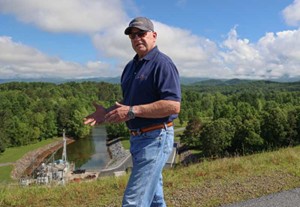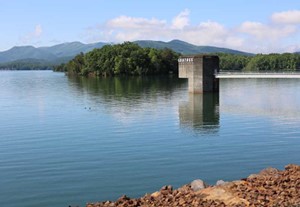 Bernie Auld, TVA Senior Program Manager, is part of a 50-person team responsible for the safety and structural integrity of TVA’s dams.
Bernie Auld, TVA Senior Program Manager, is part of a 50-person team responsible for the safety and structural integrity of TVA’s dams.
“It’s our job to protect the public,” Bernie said. “As an engineer, there are design standards that you go by, but your main focus is still the protection of the public.”
May 31 is National Dam Safety Awareness Day, but Bernie’s team doesn’t do anything special to celebrate – for them, every day revolves around dam safety.
Frequent Inspections
Bernie’s group is accountable for 90 dams on about 30 rivers and creeks across six states.
That number includes 29 conventional hydroelectric dams, plus the dam at Raccoon Mountain. Another 19 dams are non-power-generating dams designed primarily for flood control and recreation.
The remaining 41 are secondary structures such as dikes and saddle dams along the edges of reservoirs. Some of the dams are concrete. Some are earthen. Some are a combination of both. A few are over a century old. And they all get inspected. Often.
Plant and facilities staff inspect every dam monthly. Dam safety specialists then perform more extensive reviews every 15 months.
And every five years a large team of experts – including structural engineers, geological engineers, geotechnical engineers, river management staff and emergency preparedness personnel – goes over each dam with a fine-tooth comb.
Permanent monitoring equipment is built into the dam sites, and TVA deploys rovers, submersibles and drones to help with difficult-to-reach or dangerous inspections.
“What we’re looking for predominantly is change,” Bernie said. “Are there any changes that have occurred over time?”
Dam safety inspectors focus on dams’ readiness to handle big events like floods. They also make note of routine maintenance needs, such as resealing concrete joints and breaking up calcification in pipes.
For earthen dams, the biggest maintenance task is evicting uninvited guests.
Moles.
Groundhogs.
And lately, armadillos, which have been burrowing into TVA’s eight small dams along the Beech River in West Tennessee.
The Path to TVA
Bernie grew up on the Texas-Louisiana border, developing a love for Cajun and Tex-Mex food.
He attended Lamar University in Beaumont, Texas, where he majored in civil engineering and played on the football team that upset Baylor University – then ranked No. 4 in the nation – during his senior year.
He went on to get a master’s degree at the University of Tennessee, focusing on water resources. Some of Auld’s graduate school research helped persuade the state to change its dam safety requirements.
“I’ve always had an affinity for dam safety,” Bernie said.
But his career trajectory took a detour through the Golden Arches.
Auld founded his own engineering firm, which handled site design projects for McDonald’s.
“I had my hand in almost every McDonald’s from Nashville all the way to Arkansas,” Bernie said.
The recession of 2008 hit Bernie’s small firm hard.
He helped set up his employees with jobs at bigger firms. Then he submitted his resume to TVA.
“I saw an opportunity and thought, ‘Yeah, you know, I’d like to get back into what I really enjoy,’” Bernie said.
While he’s been at TVA ever since, he remains close to his roots in bayou country.
Like most TVA operations staff, Bernie keeps a go bag packed in case he needs to head out into the field on a moment’s notice.
Auld’s bag includes a toothbrush, a change of clothes and a canister of Tony Chachere’s Original Creole Seasoning.
“The essentials,” he said.
Future Generations
For Bernie, dams are primarily water barriers.
But he recognizes their benefits extend far beyond that, from power generation to flood control to navigation.
And, of course, recreation.
 A grandfather of seven, Bernie wants future generations to get the chance to enjoy outdoor adventures like he did as a kid.
A grandfather of seven, Bernie wants future generations to get the chance to enjoy outdoor adventures like he did as a kid.
Strolling recently at Chatuge Dam on the North Carolina-Georgia border – one of the 10 dams he personally oversees – Bernie gazed across the gently rippling reservoir to the mountains of the Nantahala and Chattahoochee national forests.
“I’m always in awe,” he said. “This type of vista, it never gets old – it’s just one of those you can look at all day. I thoroughly enjoy it.”
Visitor Matt Pawlowski agreed.
Matt comes to Chatuge six days a week for a brisk 5-mile walk along the reservoir. He aims to rack up 10,000-plus steps and break a sweat.
“The aesthetics, the safety of it, the path – it’s always well maintained. It checks all the boxes of what I’m trying to get done with my exercise,” the retired college football coach, who lives nearby in Hiawassee, Georgia, said.
He makes a point of chatting with TVA staff, Matt said, and he has “zero issues” with dam safety. “TVA’s a large organization and they continually have people here checking.”
That, Bernie said, is exactly the point.
His team keeps tabs on the dams so the public can enjoy the rivers and reservoirs.
Nearby, in Benton, Tenn., farmer and fisheries biology student Jacob Heiskell caught and released spotted bass and bluegill. And friends Windel Ross, SaVanna Mason and Autumn Boggs – plus Buster the dog – clambered into a raft and kayak for an afternoon float.
Towering behind them was the 135-foot-tall Ocoee Dam No. 1, TVA’s oldest dam, built in 1911.
“I’m proud that TVA puts the effort forward in maintaining dams that are over 100 years old,” Bernie said. “It’s cool just to see dams like Ocoee 1 still sitting there today, and hopefully for the next 100 years.”

